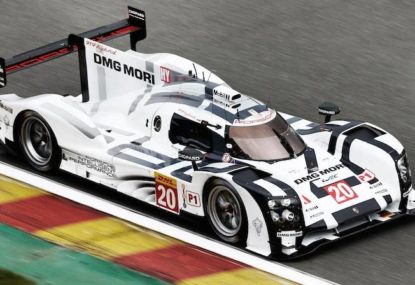Roar Guru

Mark Webber might be the Australian poster-boy for sports car racing, but most would be surprised to know there’s another Aussie behind Porsche’s World Endurance Championship victory.
After spending fourteen years in Aussie tin-tops and seven as Craig Lowndes’ long-time engineer at Triple Eight, Queensland-native Jeromy Moore entered unchartered waters to become a performance engineer for Porsche’s LMP1 programme.
Initially, there was a lot of speculation that Moore would be headed to DTM, but after closer inspection, the canny Queenslander realised that the German touring car series was merely offering more of the same in terms of room to experiment.
“DTM was on the cards. I was just looking around not knowing too much about other series as they weren’t really on my radar” says Moore. “I was happy in my current position, but you get a bit of tunnel-vision after fourteen years of doing the same thing. So I thought ‘what else is there to do for a challenge?’
“In DTM the cars are technically interesting, but after looking closer at the regulations and team politics, it detracted a bit from wanting to go there. Then the opportunity with Porsche came up.
“It’s really the top echelon of motor sport now and really competes against Formula One in terms of freedoms and technology. It really was a no brainer to take this position.”
Although poles apart in terms of technology, Moore believes there’s no better breeding ground than V8 Supercars in terms of blooding new engineering talent.
Despite being a unique series, there is more expected from team members, meaning they are exposed to more aspects of engineering which they can carry on throughout their careers.
“V8 Supercars is a great series because you can do everything”, raves Jeromy. “I was chief designer, which meant designing the suspension, working with the drivers and race engineer, damper development, tyre strategy – basically everything. It’s a really good school to learn in and a great training ground. Here is completely different of course, with aero being the most important factor.”
“While it’s the complete opposite to what V8 Supercars is, they still have four tyres touching the ground, so you have to maximise the grip over a lap. You quickly learn the things to look out for that will tweak performance. With V8 Supercars it’s all about compliance and riding the kerbs, whereas here it’s down-force, but not a peaky down-force. It’s a great challenge.”
After working within the tightly regulated world of Aussie V8s, moving to a relatively blank canvass might have broadened Moore’s horizons, but cemented his ongoing philosophy to keep pushing the boundaries.
“In V8’s you always had to be perfect given there was so little difference between the cars, where in WEC there is a buffer with the overall philosophy from driver training to the layout of the car” Jeromy explains.
“You never rest on your laurels though, you’re always pushing. You shouldn’t be in this game if you’re not. The drivers also keep you on your toes. They’re always asking what they’re doing wrong or why the other guy is faster!
“The technology here is amazing in terms of all the settings and switches to harvest energy. In V8s all we had to worry about were roll-bars and brake-bias levers!”
Young engineers trying to get a foot into the door in top-line motorsport often find themselves relegated into very segregated roles with very little opportunity to develop their own ideas. But Moore believes this doesn’t have to be the case, given that over-specialising can often lead even the best minds into the woods at times.
“Unfortunately with the level of complexity that the cars are at in WEC and Formula One now you can’t know everything” Moore explains.
“It’s great to have a basic knowledge of the concepts and design just so you know that something can be run a different way. You don’t have to know the full detail on how to optimise an upright, but as long as you know the processes involved its very to have in the background. It’s great to fall back on because I’ve seen a lot of people get pigeon-holed by just looking at their data.
“There are lots of little avenues here and there” admits Jeromy. “With each series, anyone can get locked into a pattern where they think that’s the only way things can be done. But there are always different takes on strategies. I like to be the one who’s a bit different and can offer a few different points-of-view. In this respect I think I’ve been a fairly positive addition to the team“.
Speaking with Jeromy at Fuji, the irony of competing in an endurance race close to a mountain wasn’t lost on the Australian given the sixth round of the World Endurance Championship was running parallel to the iconic Bathurst 1000 at Mount Panorama. Proving that old habits die hard, Moore admits to more than a few text exchanges with his old compadre Craig Lowndes.
“Yeah he didn’t have a great run in qualifying today!” says Jeromy. “I always follow his results of course. When you’ve been with a team for fourteen years you can’t just switch off.”
Switched on is the setting that Moore knows best.